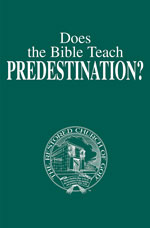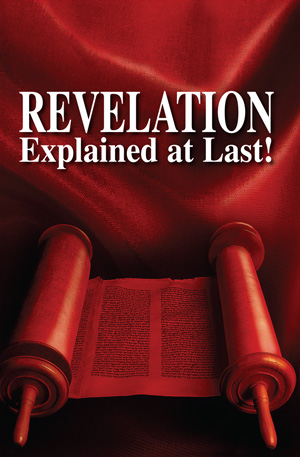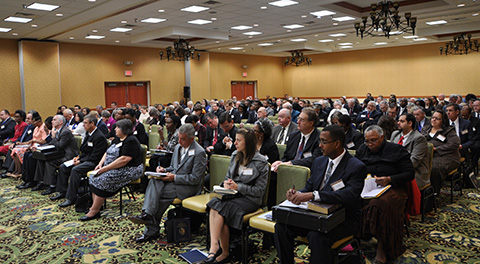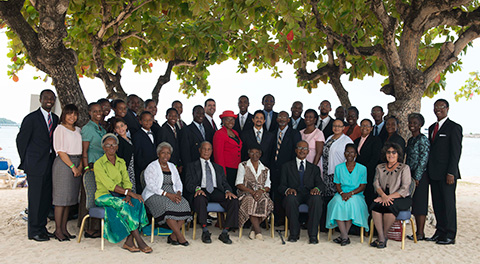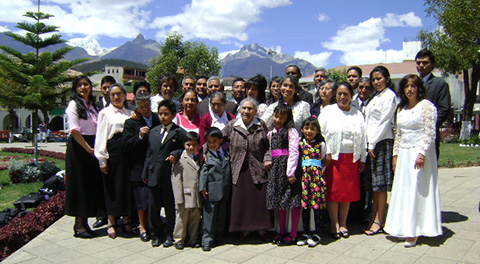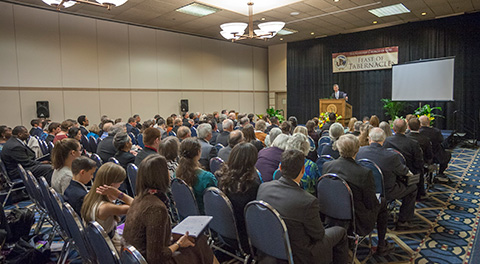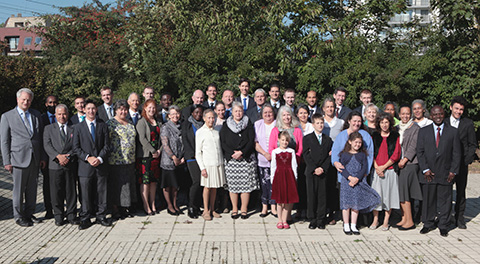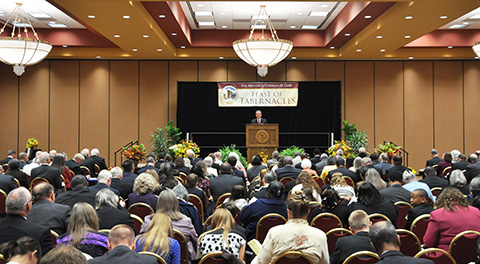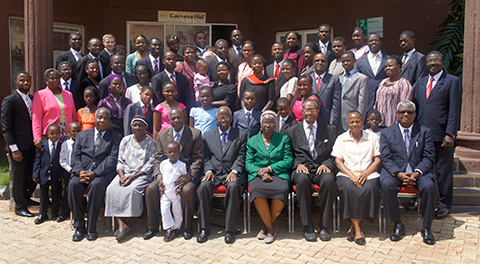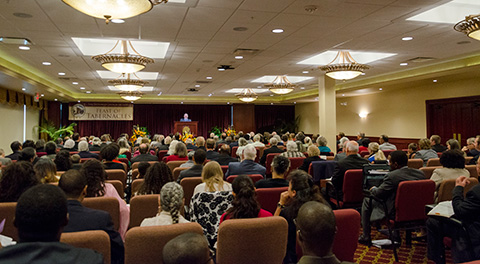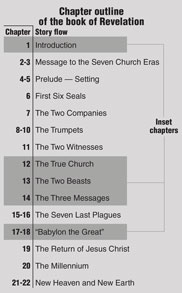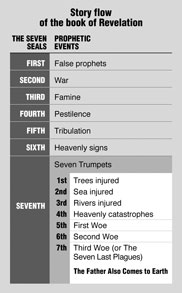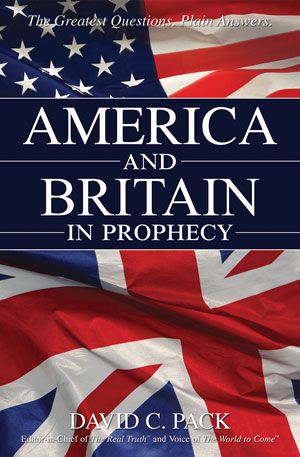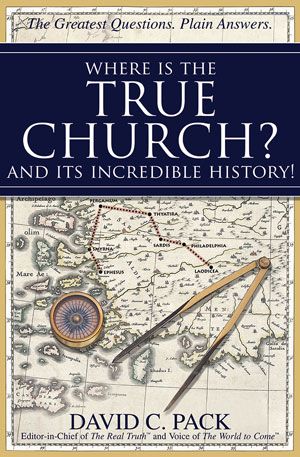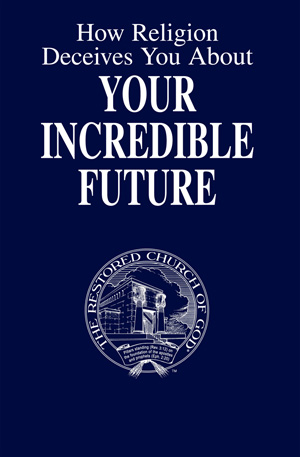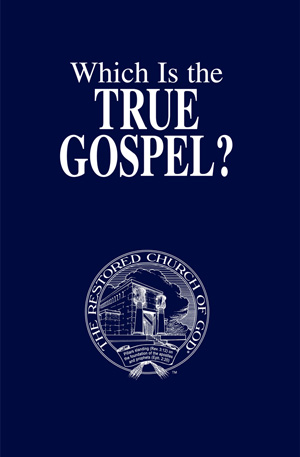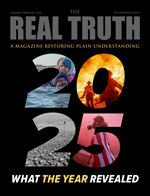Unrest grows daily around the world. Terrorism mounts. Bad news increases, while good news is increasingly scarce. Conditions worsen daily!
Man has tapped the power of the atom. Science and technology have seemingly run amok, producing more horrific new inventions. Now, more and more countries possess weapons of mass destruction. This danger is compounded because mistrust and strife between nations has never been greater.
Also, human decadence and immorality, famine, disease, racism and competition among ethnic rivals, and crime and violence are exploding. Where are these downward trends leading? Will human life survive?
What does the future hold? All want to know. Many have opinions, but few recognize where to find the answers. Others think they understand the prophecies of the Bible—and this is probably most true of the book of Revelation. Yet all popular human interpretations of this book, at best, border on ridiculous. They are a complete jumble of ideas where a little truth is mixed with much error! They are almost painful to read—yet major magazines report that great numbers do believe these dangerous, counterfeit scenarios.
What is the truth about prophecy? Sobering world conditions make this question loom larger than ever before. Nothing that has occurred over the past 6,000 years even remotely compares to what is yet to come upon this world! But most have no idea how to frame the great events of prophecy—when do they occur as well as where and to whom?
The Bible foretells a time of world peace, happiness, abundance and universal prosperity. Many may think there is no hope for this world—but there is! Wonderful good news lies beyond today’s bad news. The great Creator God will soon intervene and save humanity from itself.
But just beforehand, and lasting through the initial phase of this intervention, world trouble will greatly increase—eventually intensifying to staggering proportions. Unexpected and cataclysmic events will shake the whole world! Civilization as we know it will forever change.
But understand: Contrary to the assumptions of millions of people who do not understand Revelation, the next time of trouble is not the time described in Revelation! Virtually no one knows this. The prophet Jeremiah calls this imminent time that of “Jacob’s trouble” (30:7). Jacob consists of the modern tribes of Israel (Gen. 32:28)—primarily the English-speaking peoples of the West. (My book America and Britain in Prophecy offers extensive proof regarding national identities.) Jacob’s punishment is God’s focus. It will be the worst time of all time for a specific group of nations. Almost no one knows there are three great times of punishment coming, with the first centered on those descended from the patriarch Jacob with punishment soon after on all nations. The second period is focused primarily on the tribe of Judah, described by Christ as “great tribulation” (Matt. 24:21). The third overall time of punishment is entirely on all nations of the world. Revelation clearly shows events that strike the whole world from the beginning. This will become plain.
God has not left mankind without a source of answers that reveals in detail what lies ahead. Tragically, believing things will eventually “turn out all right,” many hide their eyes, choosing to pursue pleasure and the accumulation of material goods. But for the short term, things will not turn out all right. World conditions are—and will become—far more serious than most realize.
God understands human nature and where it always leads when left to its own devices. This allows Him to know, and to guide, the awesome future events that will occur from now on!
Timing
It has become God’s time to reveal what lies ahead—short and long-term. The stage is set and He has lifted the curtain on the future. Revelation describes terrible plagues and world-shattering—truly Earth-shaking—events!
But careful study reveals they follow a long period of God’s Kingdom on Earth. A just God would not bring undiluted punishment on an entire mankind who did not have opportunity to learn and practice His way of life.
After the above-described “Jacob’s trouble” afflicting the descendants of modern Israel, the territory of God’s Kingdom will spread to encompass all the Israelite nations, ushering in unprecedented tranquility in our time. (You will greatly benefit from the booklet How God’s Kingdom Will Come – The Untold Story! It will help make clear that God’s Kingdom arrives long before events of Revelation.)
During this Kingdom, God will give mankind everything—peace, prosperity, and happiness. But after generations of reaping these blessings, vast numbers will choose their own way, turning their backs on God. And, shockingly, this cycle will unfold again—resulting in the punishment detailed in Revelation.
With this in mind, recognize that the events of Revelation described in this booklet are far in the future. But they can be understood now!
Mystery Book
Signs, seals, symbols, vials, visions, trumpets, thrones, plagues, angels, beasts, heads, horns, witnesses, woes, wars, numbers, multitudes, messages and mystery! Revelation contains all of these terms. But what do they mean?
Most believe that the book of Revelation is sealed, closed from understanding. It is called a mystery book without meaning. Yet it is an entire book of important—vital—meaning. It is filled with answers. The above terms can be unlocked! They can be understood—and this eye-opening booklet contains the necessary keys!
You will be intrigued—even fascinated—by the clarity of what can be known from the book of Revelation. Events are building to a final culmination—a tremendous CLIMAX! You can know them.
One-third of the Bible is prophecy—the future written in advance! The Bible is approximately 750,000 words, with about 250,000 devoted to many, many prophecies. Almost half the books of the Old Testament are included in either the so-called “major” or “former” prophets (Isaiah, Jeremiah, Ezekiel) or the “minor” or “latter” prophets (Daniel, Hosea, Joel and 10 others).
The apostle Paul explained that the New Testament Church was “…built on the foundation of the apostles and prophets” (Eph. 2:20). Recognize that, since the Church stands on the words of the prophets, Christians are to understand prophecy. If God commands men to “live by every word of God” (Matt. 4:4; Luke 4:4; Deut. 8:3), He would not exclude the full third that is prophecy!
The prophet Daniel spoke of a time when “…many shall run to and fro, and knowledge shall be increased” (12:4). This has happened! Then, speaking of the end time, he said, “…the wise shall understand” (vs. 10).
God has opened up—revealed!—to His servants what lies ahead. He may want you to understand. He does not want those who obey Him confused, ignorant or fearful of the future.
Then what are the wise to understand? Important keys exist, which open up Bible prophecies. But the world knows nothing of them! No wonder so many claim that the meaning of Revelation cannot be explained. How could they understand without the keys?
Imagine. Forty-two percent of Americans actually believe that they can consult the dead about matters involving the future. But mankind refuses to seek and consult GOD. Only He can reveal the future. Mankind cannot, through intelligence, human reasoning or scientific discovery, know or discern events to come. And many “religious” people believe that the book of Revelation offers no help anyway, because it cannot be understood.
But God is working out a supreme Master Plan, involving every human being. However, Daniel 12:10 adds, “…but none of the wicked shall understand,” because God will not reveal His plans to those who do not obey Him!
Psalm 111:10 says, “A good understanding have all they that DO His commandments.” God only gives understanding to those who do what He says!
Revelation Means a Revealing
After Daniel finished recording the prophecy, he asked God to explain what it meant. Though Daniel was used to record the book, even he did not understand it: “I heard, but I understood not” (12:8). God answered, “Go your way…the words are closed up and sealed till the time of the end ” (vs. 9 – the Moffatt translation is even stronger by rendering this “till the crisis at the close”).
While Daniel was not allowed to understand what he wrote, those who live in the time of the end can! And we have seen that the wise DO! Daniel contains a mixture of history, prophecy that has been fulfilled, prophecy soon to be fulfilled, and a few elements of prophecy that will be fulfilled centuries in the future—at the time of Revelation.
We will see that the book of Revelation was also sealed with seven separate seals. It is crucial to understand another key point: The seven seals in God’s hand essentially span all but the last two chapters of the book! The seven seals are opened one by one, in sequence. Each reveals events before they happen. Only Christ is qualified to remove the seven seals and open the book to understanding.
The Greek word apocalypse is translated “revelation.” This English word actually means to reveal—not conceal, hide, veil or close up. The dictionary definition of revelation is: “The act of revealing or disclosing; something revealed, especially a dramatic disclosure of something not previously known or realized.”
In the first verse of the book, the apostle John recorded Christ’s words, “The Revelation of Jesus Christ…to show unto His servants things which must shortly come to pass.” Near the end of the book, Revelation 22:10 states, “Seal not the sayings of the prophecy of this book: for the time is at hand.”
Comprehend John’s words. The time for understanding the book of Revelation IS now at hand!
God reveals a basic framework for understanding future events. This framework is primarily laid out in Daniel and Revelation. Daniel, recorded 600 years earlier, sets the stage for the larger and more detailed book of Revelation, which describes many events nowhere else in the Bible.
Understand! By naming the book “Revelation,” God makes clear that the book is not a review or a reiteration. It is not merely a re-telling of what can be learned in the Old Testament, or elsewhere in the New. The book contains elements of God’s Plan that were “revealed” decades after the rest of the Bible was recorded. All the apostles but John knew nothing about it because they died decades before John received it.
Its 22 chapters stand on their own. Treating Revelation exactly as God intended—as a book that contains different, additional prophecies, largely separate from those previously recorded in His Word—becomes the first great key to unlocking the book!
Revelation outlines a long series of events that relate to one another in a continuous flow—comprising an entire story. These occur in order of time sequence. (The center of this booklet contains two overview graphs—an outline and a story flow—to which the reader may occasionally refer.) Also, Christ periodically insets certain events into the course of the Revelation. You now understand a second key to unlock the book!
Now a third all-important key! Revelation explains many things that happen deeper into God’s Plan, which would be lost to the understanding of billions if we did not have this book. Endless speculation would arise over what God was going to do in His Plan’s next phases. He would have to reveal these things.
The Signs of Christ’s Coming Parallel the Seven Seals
One of the basic rules of Bible study is to always let the Bible interpret itself. This is probably never truer than in the book of Revelation. This will be done as we progress through the opening of the seven seals.
Since John sees many symbols, we need to be able to understand the actual events that they represent. Otherwise, we will not know what is being described.
How do we do this?
Mark 4:10-12 and Matthew 13:10-15 hold a fourth key to understanding how Christ teaches. In both places, He explained that He spoke in parables so that His true servants would understand Him—but others would not! Carefully read these verses: “And when He was alone [with only the disciples], they that were about Him with the twelve asked of Him the parable. And He said unto them [not to others, or to the world as a whole], Unto you it is given to know the mystery of the kingdom of God: but unto them that are without, all these things are done in parables: that seeing they may see, and not perceive; and hearing they may hear, and not understand; lest at any time they should be converted, and their sins should be forgiven them” (Mark 4:10-12).
Note exactly what Christ said! Only His servants could understand His real meaning. Others might think they do—but they cannot!
Christ never leaves His servants in the dark about matters He wants them to understand. But He does record them in ways that keep them hidden from the view of all others. This will help you see why so few understand a book that has been read by so many.
We have already touched upon the principle that the unrighteous do not understand events lying just ahead. But those who have God’s Spirit will understand (Acts 5:32; John 16:13). Only through God’s Spirit leading those who are obeying Him can they understand the truth. Recognizing and accepting these two verses is of vital importance to every reader of this booklet—and of the book of Revelation. All who do not seek to obey God, even if they may sincerely seek to understand the many truths of prophecy, are wasting their time.
Jesus explained, in plain, clear language, the key events of the last days preceding and leading to the time of His Second Coming to Jerusalem. Remember, Jesus’ disciples asked Him privately, “Tell us, when shall these things be? And what shall be the sign of Your coming, and of the end of the world [age]?” (Matt. 24:3; Luke 21:7).
Before examining Christ’s answer, recognize that God often employs the principle of duality. Early events can be types or forerunners of latter fulfillments. As previously noted, Christ returns and establishes His Kingdom well ahead of the events of Revelation. But there are parallels between an earlier coming, not far ahead, and the run-up to His later 1,000-year reign. Keeping this principle of duality in mind, note the unmistakable similarities between what is described in the gospels—speaking of our time—and the much later time of Revelation.
Let’s briefly examine the critical Matthew 24 chapter for vital clues, which explain the symbols that we will study in Revelation. Christ gave a list of six different events that are to happen before His Coming to Jerusalem. They largely parallel the seals—including the four horsemen—of Revelation 6. God so often does important things in prophecy twice!
First—deceivers arise among God’s people (Matt. 24:5). Second come wars (vs. 6) throughout the age, culminating in the end time with world war (vs. 7). Third are famines and fourth come pestilences (both also vs. 7). It is at this point that Christ inserted a reference to the destruction of Jerusalem, in AD 70, because this was a forerunner, or type, of the yet future siege of Jerusalem. Therefore, Matthew 24:9-28 (also Luke 21:12-24) applies to the period of AD 70—but only as a forerunning type of the final time of the end to which His warning refers literally!
Fifth, in Matthew 24:21-22, Christ explains that Great Tribulation occurs. Sixth are Heavenly Signs (vs. 29)—when the stars fall and the sun and moon are darkened. The sign of Christ’s Coming (vs. 30) occurs at this same time. His actual Coming to Jerusalem is right on the heels of it. The colossal seventh seal—which are the seven trumpet plagues—is conspicuously absent in the gospels. The events of Matthew are for our time and merely parallel the much later time of Revelation when the whole world receives the kinds of things found in Matthew 24. Studying this early type provides insight about the later time.
We will now examine Revelation, chapter by chapter.
Chapter 1: Christ the Revelator and the Book’s Theme
Understanding who is the actual author of the Revelation—and understanding the critically important theme, the centerpiece of the book, is vital. Without these keys, many have bogged down into either arguments about whether “the Lord’s Day” (vs. 10) is a reference to Sunday—or whether John, instead of Christ, authored the book.
Why does almost everyone refer to this book as “The Revelation of St. John the Divine”? Nowhere does it refer to John as either divine or the Revelator. So the primary purpose of Chapter 1 is to establish Jesus Christ as the book’s Author.
Notice: “The Revelation of Jesus Christ, which God gave unto Him, to show unto His servants things which must shortly come to pass; and He sent and signified it by His angel unto His servant John: who bare record of the word of God, and of the testimony of Jesus Christ, and of all things that he saw” (vs. 1-2).
Did you notice that the book of Revelation contains Jesus Christ’s words, as the Revelator, not John’s words? John was merely a scribe—a secretary taking dictation.
Anyone who carefully examines this verse will plainly see that the Revelation originated with God (the Father), who gave it to Christ. Christ sent and signified the Revelation by His angel, who then gave it to John, “who bare record of the word of God, and of the testimony of Jesus Christ, and of all things that he saw” (vs. 2). John merely recorded these events, preserving them for the servants of Jesus Christ—His end-time Church.
As soon as the book was copied and canonized (about AD 100), the founders of the developing universal church at Rome denied its origin. The highly authoritative and famous 11th edition of The Encyclopaedia Britannica states, “Instead of this [Rev. 1:1] the Church substituted the name of the disciple through whom the message was delivered for that of his Master, and designated our Apocalypse ‘The Apocalypse of John.’ This title was familiar before the end of the 2nd century” (vol. 23, p. 212).
If the world’s best minds cannot even discern the book’s correct title—and Author—how could they discern its message?
Christ used John to “bear record of” (vs. 2)—write down—what He was revealing. In short, John wrote three things: (1) The word of God, (2) the direct testimony (words) of Christ, and (3) what he saw in vision.
With this background, you now understand the introduction to the book.
The Theme
Many scholars claim that the term “the Lord’s Day” is, in fact, a reference to the day of the Lord of the Old Testament! But it is not! Almost no one understands this. Without this central point correct in one’s thinking, the entire book will make no sense. Reading Revelation becomes a fruitless exercise. Revelation 1:7 describes the nations “wailing” at Christ’s Return to Jerusalem. Mere basic comparison to Matthew 24:30 where they “mourn”—the same word translated “wailing” in Revelation 1:7—proves this is the same day Christ descends into Jerusalem.
Now notice verse 10. This verse actually reveals the central focus or theme of the whole book. Understand that John lived over 1,900 years ago—long before the events of this book were to be fulfilled. He wrote, “I was in the Spirit on the Lord’s day, and heard behind Me a great voice, as of a trumpet.”
Centuries of controversy have sprung from this reference, because people argue about which day of the week John is referring to. The presumption is that he is talking about Sunday. This verse has nothing to do with Sunday—it does not reference any day of the week! The day of the week John received this prophecy is irrelevant.
So the “Lord’s Day” is here speaking of a time much closer to the present, not the more distant time of Revelation. Many passages make clear that there are multiple “days of the Lord,” as well as a period of time called the “days of the Son of Man” (Luke 17:22, 26).
The prophet Joel speaks of this day. Here is a small portion of how he describes the day: “Blow you the trumpet in Zion, and sound an alarm in My holy mountain: let all the inhabitants of the land tremble: for the day of the Lord comes, for it is near at hand; a day of darkness and of gloominess, a day of clouds and of thick darkness, as the morning spread upon the mountains…” (2:1-2).
This is a day that lies in the near future. And it has nothing to do with the events of Revelation, which so many think will come next.
The prophet Zephaniah is even more graphic than Joel: “Hold your peace at the presence of the Lord God: for the day of the Lord is at hand: for the Lord has prepared a sacrifice, He has bid His guests. And it shall come to pass in the day of the Lord’s sacrifice, that I will punish the princes and the kings’ children, and all such as are clothed with strange apparel. In the same day also will I punish all those that leap on the threshold, which fill their masters’ houses with violence and deceit. And it shall come to pass in that day…” (1:7-10).
A few verses later, Zephaniah gives more insight into just how terrible this time will be. Consider this sobering picture: “The great day of the Lord is near, it is near, and hastes greatly, even the voice of the day of the Lord : the mighty man shall cry there bitterly. That day is a day of wrath, a day of trouble and distress, a day of wasteness and desolation, a day of darkness and gloominess, a day of clouds and thick darkness, a day of the trumpet and alarm…And I will bring distress upon men, that they shall walk like blind men, because they have sinned against the Lord: and their blood shall be poured out as dust, and their flesh as the dung” (vs. 14-17).
This presents a horrible picture. Verse 18 refers to this time as “the day of the Lord’s wrath.” Verse 17 identifies the cause of God’s Wrath: “because they have sinned against the Lord.”
Events depicted here—God’s time of punishment—are almost more awful and terrifying than words can describe. This day literally belongs to God. Man’s conduct has made God angry. And He will soon intervene in the affairs of this world.
These prophecies precede and type the truly terrible time of God’s punishments, plagues and judgments when the book of Revelation is fulfilled at the end of the Kingdom of God. Christ, through John, is revealing to His servants what occurs after the Kingdom! It is a graphic description of world punishment on peoples who did not appreciate God’s Kingdom after it had been present for many centuries.
Ezekiel 8:3 gives some insight into how John could be transported 1,900 years into the future. Notice: “The spirit lifted me up between the earth and the heaven, and brought me in the visions of God to Jerusalem.” Like Ezekiel, John was in vision—“in the spirit”—from the Isle of Patmos, where he recorded the Revelation. In the past, God has projected His servants (through visions) into important future events so that they could record them.
We are in the time of the end, when God wants His servants to understand the last events preceding the Return of Christ. This means knowing that the book of Revelation does not speak to unknown events in the distant past or things just ahead. It warns of colossal events that will affect the masses of humanity. Grasp that the final day of God’s wrath is the towering centerpiece of the entire book. Thus, it has required more explanation to understand what we will read in the balance of this booklet.
In Revelation 1:3, God states, “…he that reads, and they that hear the words of this prophecy, and keep [obey] those things which are written” are “blessed.” What would be the point of this verse if God did not want the reader—the “hearer”—the “keeper” (obeyer)—to understand it? This is an important statement to all who read the book. It means you!
Verses 14-16 are a direct description of Christ, as He now exists in full glory. This is an awe-inspiring picture. Take a moment to meditate on it—and how it is a far cry from the common image of the popular long-haired, sallow-complexioned, sad-faced, false “Christ” of this world: “His head and His hairs were white like wool, as white as snow; and His eyes were as a flame of fire; And His feet like unto fine brass, as if they burned in a furnace; and His voice as the sound of many waters. And He had in His right hand seven stars: and out of His mouth went a sharp two-edged sword: and His countenance was as the sun shines in his strength.”
There are two types of symbols used in the first chapter of Revelation. One is mentioned in verse 12, where John saw “seven golden candlesticks.” Also, in verse 16, he saw “seven stars” in Christ’s hand.
Their meaning is explained by simply continuing to read the context. The explanation is in verse 20: “The mystery of the seven stars which you saw in My right hand, and the seven golden candlesticks. The seven stars are the angels of the seven churches: and the seven candlesticks which you saw are the seven churches.”
Remember, the Bible interprets itself! And we have just introduced the subject of the next two chapters.
Chapters 2 and 3: The Seven Church Messages
Chapters 2 and 3 contain Christ’s messages to seven different churches in Asia Minor—today’s western Turkey. Combined, these messages represent the first overall message of the book. They are directed to the seven successive eras, or stages, of the Church, and span the entire New Testament period—from the time Christ built His true Church (Matt. 16:18) in AD 31, until His Second Coming, just ahead! God has chosen to work with His Church through sequential eras. Each message contains Christ’s brief description of the spiritual condition of these seven consecutive Church eras.
These messages are not spoken to the many well-known, respected denominations of this world’s professing Christianity. They are directed to God’s one true Church. Men have never understood the messages, because they have never recognized how to identify God’s Church.
All are described as having their own unique set of doctrinal and spiritual problems (Smyrna and Philadelphia are exceptions) that eventually lead to Christ raising up a new leader to establish the next era. These eras are known as Ephesus (2:1), Smyrna (2:8), Pergamos (2:12), Thyatira (2:18), Sardis (3:1), Philadelphia (3:7) and Laodicea (3:14).
These were actually seven cities lying close together (in this order) on a mail route in Asia Minor. God knew that each city would reflect a corresponding attitude existing in the era it represents. Christ was able to use them to show a pattern that would span the 2,000-year history of His Church.
History demonstrates that most in each of these eras did not heed the warnings spoken to them by Christ. This is never truer than at the end of the age. While the Church has now progressed into the deplorable, seventh (or last) era, known as Laodicea, the most faithful brethren in the Church of God today are a remnant of the sixth, the Philadelphian era. They remain separate from the lukewarm seventh era. (Read our book Where Is the True Church? – and Its Incredible History!)
Chapter 4: Before God’s Throne and the Twenty-four Elders
The 4th and 5th chapters represent the setting for the central part of the Revelation, which is to follow. They set the stage for unveiling the great prophecies explaining the theme of the book.
In verse 1, John describes a door opening in heaven and an invitation from a great voice to “come up” to be shown things “which must be hereafter.” Understand that John was actually on a small island (Patmos) in the Mediterranean Sea and all of what he saw was occurring in vision. He was not literally in heaven.
In verse 2, John saw the Father on His throne, introducing Him and presenting a magnificent picture of the setting in which God exists. Surrounding Him are 24 additional “seats” (lesser thrones), occupied by “twenty-four elders.”
It is important to study this chapter with chapter 5, because they present a descriptive picture of four “beasts” (living creatures), as well as the twenty-four elders—and Jesus Christ, as the Lamb of God (vs. 6), standing before God’s throne.
This awe-inspiring setting pictures the environment—atmosphere—magnificent beauty—of God’s throne. The description is simply stunning!
Chapter 5: Christ Unseals the Prophecy
Verse 1 pictures the Father holding the entire book of Revelation (with seven seals upon it) in His right hand. At this point, the book (actually a scroll or parchment) is still unopened—sealed—locked! Now notice: “And I saw in the right hand of Him that sat on the throne a book written within and on the backside, sealed with seven seals.”
Seven is God’s number of completeness—and, of course, the book was also completely sealed. This means that the meaning of the prophecy has remained hidden from view—unavailable to mankind! It has not even been possible to read it correctly in proper sequence, let alone understand it.
Here is the description: “And I saw a strong angel proclaiming with a loud voice, Who is worthy to open the book, and to loose the seals thereof? And no man in heaven, nor in earth, neither under the earth, was able to open the book, neither to look thereon. And I wept much, because no man was found worthy to open and to read the book, neither to look thereon” (vs. 2-4).
The account reveals that no man is qualified to open the book. If only men would simply believe God, there would not have been so many men, over the centuries, giving their interpretations of a prophecy that cannot possibly be understood. Like Daniel, who recorded a prophecy he did not understand, John was also unable to comprehend this prophecy. He actually cried because he did not see any way to open the book (vs. 5).
It is at this point that Christ, and Christ alone (not any human being), is deemed to be “worthy” to UNSEAL THE BOOK!
Understand this! The interpretation of the book of Revelation is not that of The Restored Church of God, or any person within it, including me. No man is capable of opening a single prophecy in this book.
The book of Revelation has been available in English since the King James version was translated from the original Greek in 1611. So, on the surface, this is a difficult point to understand because, of course, many have opened the Bible to this book and read all of its 22 chapters. But they have not correctly understood it. Because they have not believed chapter 5—that Jesus Christ has sole authority to unseal the book. Endless differing, competing, humanly-devised “interpretations,” creating much confusion, have floated around for 2,000 years. Popular modern novelists have only made this worse.
Do not be confused about who alone can open this book to correct understanding. Remember, Daniel’s book is a counterpart detailing much that will happen prior to Revelation, and his book was “sealed till the time of the end” (12:9).
Christ reveals the meaning of these prophecies: “and He came and took the book out of the right hand of Him that sat upon the throne” (Rev. 5:7).
The Twenty-four Elders Explained
Let’s notice something else about the twenty-four elders—and clear up a misunderstanding that has existed about who and what they are.
First read chapter five’s additional reference to them: “And when He had taken the book, the four beasts and four and twenty elders fell down before the Lamb, having every one of them harps, and golden vials full of odors, which are the prayers of the saints. And they sung a new song, saying, You are worthy to take the book, and to open the seals thereof: for You were slain, and have redeemed us [them] to God by the blood out of every kindred, and tongue, and people, and nation; And have made us [them] unto our God kings and priests: and we [they] shall reign on the earth” (vs. 8-10).
Some claim the twenty-four elders are taken from saved human beings. This idea comes from a mistranslation of the italicized words “us” and “we.” They should be replaced by the words in brackets. See the Revised Standard Version, and also the margin of the New King James Version. Both render them correctly.
These elders are spirit beings created by God to be His counselors. They were probably created before the physical creation, along with the cherubim (Michael, Gabriel and Lucifer—who became Satan), the seraphim, the four living creatures and the billions of other angels (vs. 11) that serve God.
It is impossible for the twenty-four elders to be resurrected saints. Jesus said, “And no man has ascended up to heaven, but He that came down from heaven, even the Son of man which is in heaven” (John 3:13). Only when Christ returns to Earth will Christians be given immortality (I Cor. 15:23)!
The twenty-four elders rule with God in heaven, having an advisory role to Him. The resurrected saints will rule on Earth (Rev. 20:4; Matt. 5:5; Dan. 7:27). Though the vision that John saw is unsealed in heaven, it reflects events that will occur “on the earth.”
Chapter 6: The Seals Are Opened
We now come to the critically important chapter 6—and the beginning of Christ’s one-by-one removal of each of the seven seals.
First, again understand that, beginning with chapter 6, unsealing the seven seals spans the next 15 chapters of the book. But since chapter 6 explains six of the seven seals, obviously they do not individually receive a large amount of space. The seventh seal is so important—and so multi-faceted—that God devotes much space to its complete explanation. Most of the remainder of the book is devoted to just the seventh seal!
This is another key to understanding the whole book.
The world sees the Apocalypse as a mystic, cryptic message of doom! The first four seals are represented by four riders, on four different-colored horses. Of course, much has been said and written about them. But “the four horsemen of the Apocalypse,” as they are commonly referred to, are still viewed as mysterious, unexplained horrors to be unleashed upon the world without warning.
To clearly understand the first seal of Revelation 6:2, we must accept a basic fact. Recall, the Greek term apocalypse simply means “revelation.” So let’s now explain what is to be revealed—the seven seals.
We will read the description of each seal before discussing it. Remember, God wants His servants—“the wise”—to understand!
The First Seal—FALSE CHRISTIANITY
Let’s now examine the first seal: “And I saw when the Lamb opened one of the seals, and I heard, as it were the noise of thunder, one of the four beasts saying, Come and see. And I saw, and behold a white horse: and he that sat on him had a bow; and a crown was given unto him: and he went forth conquering, and to conquer” (vs. 1-2).
What John records is written in symbols. He does not speak in plain language. It is impossible to understand these symbols by merely re-reading Revelation 6 over and over until their correct meaning sort of “pops into your head.”
It is also absolutely critical to recognize that an endless list of human interpretations is available for what this horse and the others represent. But, once again, the Bible interprets the Bible. We must permit Christ to explain what He is unsealing! No one else has any authority to speak for what God gave to Christ—and authorized Him to reveal!
Christ Interprets
Christ reveals the meaning of the white horse by explaining its much earlier type, to come in our time. Recall that His disciples asked Him in Matthew 24, “…when shall these things [the destruction of the temple] be? and what shall be the sign of Your coming, and of the end of the world?” (vs. 3).
Understand that Christ is speaking in both Matthew 24 and Revelation 6. He answers His disciples by listing, in time sequence and order, the events and trends that precede the end of the age—and thus His Coming.
Now notice that there is a parallel between Revelation 6:1-2 and Matthew 24:4-5: “And Jesus answered and said unto them, Take heed that no man deceive you. For many shall come in My Name, saying, I am Christ [that Christ is Christ]; and shall deceive many .” That’s right! Christ warned that the many would be deceived by those who claim to represent Him—not the few. This has been fulfilled in the form of an apostasy (“defection from truth”) that unfolded in the Church of God in the late 20th century—allowed by God as a great test.
The white horse that John described represents a false “christ” and false Christianity. Here is proof. The one sitting on this horse is actually a counterfeit of the true Christ described in Revelation 19:11-16. There, the real Christ wields a sharp two-edged sword , while the false christ is represented as carrying a bow . Do not overlook this critical difference!
Here is a partial description of the true Christ returning in great power and glory at the outset of the Millennium. While it does show Him riding a white horse, the rest of the description is very different: “And I saw heaven opened, and behold a white horse; and He that sat upon him was called Faithful and True, and in righteousness He does judge and make war…And out of His mouth goes a sharp sword, that with it He should smite the nations: and He shall rule them with a rod of iron: and He treads the winepress of the fierceness and wrath of Almighty God” (vs. 11, 15).
Consider for a moment. Most who study Revelation believe that the white horse of the first seal pictures the true Christ coming before war, famine, and disease, etc., strike the Earth at that time. How ridiculous! Such ignorance and misunderstanding has clouded the timing of the glorious final Return of Jesus Christ described in Revelation 19:11-16. This is but one more way that false religion—the other white horse—has deceived professing Christianity.
Parallel Chapters
Before proceeding, let’s read more of Christ’s answer to His disciples in Matthew 24. It will prepare us to further see the parallel between it and Revelation 6.
Carefully notice: “And you shall hear of wars and rumors of wars: see that you be not troubled: for all these things must come to pass, but the end is not yet. For nation shall rise against nation, and kingdom against kingdom: and there shall be famines, and pestilences, and earthquakes, in various places. All these are the beginning of sorrows” (vs. 6-8).
Christ gives a direct answer to a direct question. The events He describes require no interpretation. By having these early forerunners in mind as we read the opening of the remaining seals, we have Christ telling us in advance what we are viewing—and what the symbols mean. All mystery is stripped away.
But, it is important to understand that only NOW, after almost 2,000 years, can the book of Revelation be opened up to plain understanding for all those who will heed. The words have always been there, but their meaning has been “sealed till the time of the end.”
Grasp what you have just read!
In effect, Christ has given an advance newscast—newspaper headlines—of events now lying just ahead. Matthew 24, coupled with Mark 13 and Luke 21, comprise what is commonly called “The Olivet Prophecy,” because Christ delivered it while sitting with His disciples on the Mount of Olives. The entirety of these three chapters contains much more information than just Matthew 24:3-8. But we are not yet ready to discuss it.
In John 1, Christ is referred to as “the Word.” Compare verse 1 and verse 14. “The Word” is translated from the Greek word logos, meaning “Spokesman.” Actually, Jesus Christ not only inspired Matthew 24 and Revelation 6, but also the entire Bible!
For those with “eyes to see and ears to hear,” in Matthew 24, Christ is revealing clues in plain language about the true meaning of the symbols recorded in Revelation 6, though their fulfillment is centuries beyond the time of Matthew 24. Remember duality.
Understanding the last sentence is the single biggest key to understanding the entire book of Revelation!
Parables are much like symbols. Both are different from the actual things or figures being described. As explained, while most believe that Christ spoke in parables to illustrate His meaning, He said otherwise in Mark 4:10-12, when discussing the parable of the Sower and the Seed. The real reason Christ spoke in parables was to HIDE His meaning. The same is true of symbols! It is the use of these symbols in Revelation 6 that kept the prophecy locked—sealed!
If you read the account in Mark, you will find that Christ explains the Parable of the Sower privately to His disciples. This is exactly what He did in Matthew 24. He explained privately to His disciples then, and for His disciples of the end time, the meaning of the Revelation 6 symbols.
When the disciples wanted to understand the events that would precede Christ’s Return, they asked HIM, not some uninformed churchman or theologian who could have no idea what he is talking about.
You can do the same. Christ is “the same yesterday, today and forever” (Heb. 13:8). What He revealed to the disciples long ago is just as true for us today! And the events of the Olivet Prophecy are prophesied to occur in our time. So, if the first-century disciples desired to know the answer to their question of Matthew 24:3, how much MORE should today’s disciples want to plainly understand what will directly affect their lives?
Understand one final point about Christ’s explanation of the opening of the seals. Each represents a prophetic trend that begins and remains continuous from the moment it is opened, after the earlier phases of the Kingdom end, all the way to His final Coming at the Millennium’s start.
In II Corinthians 11:13-15, Paul recorded how false ministers (or false christs) do their work—deluding, deceiving and causing vast numbers of people to accept counterfeit christs (vs. 4). While this has been happening for 2,000 years, all but the few—to whom Christ is revealing His precious truth—are completely oblivious! This includes deceitful misrepresentation of the entire book of Revelation.
False ministers and deceivers were prophesied to delude the “many”—not the “few.”
As a forerunner to later fulfillments, almost immediately after Christ’s death and resurrection, false ministers and deceivers entered His true flock. This is the very reason why He warned each of the seven eras of chapters two and three with separate messages.
The Second Seal—WAR
When the second seal opens, a red horse appears: “And when He had opened the second seal, I heard the second beast say, Come and see. And there went out another horse that was red: and power was given to him that sat thereon to take peace from the earth, and that they should kill one another: and there was given unto him a great sword” (vs. 3-4). As with Christ in Revelation 19, the sword here is depicted as an instrument of war and killing.
This horse and rider “take peace from the earth.” The opposite of peace is war. When peace is removed, war is what remains. This part of John’s astounding vision has the gravest implications for all alive when the seals open.
This horseman represents the dreadful destruction of world war. In the Matthew 24 parallel prophecy, war follows false religion. After the end of the long phase of the peaceful Kingdom period, war holds the power to take peace not just from two or more nations, but now “from the earth.”
Only in the modern age have such terrible weapons of mass destruction been available. The twentieth century saw the two most devastating wars in history, with World War II far more destructive than World War I.
We are now in a recess—intermission—preceding a time of truly great war, prophesied to exceed anything in the last century, and only to be exceeded by the events of Revelation themselves. A sinning, rebellious humanity will soon reach the end of its rope. We have reached a time when war’s potential cannot grow worse, but can now erase all life from Earth in one final blast of complete destruction—if Christ did not intervene and cut events “short” (vs. 22).
The pattern of history is that famine always follows war. This is why famine (the third seal) follows on the heels of war (the second seal).
The Third Seal—FAMINE
The third seal opens and a black horse, a symbol of famine, appears: “And when He had opened the third seal, I heard the third beast say, Come and see. And I beheld, and lo a black horse; and he that sat on him had a pair of balances in his hand. And I heard a voice in the midst of the four beasts say, A measure of wheat for a penny, and three measures of barley for a penny; and see you hurt not the oil and the wine” (vs. 5-6).
This pictures extreme worldwide famine, beyond anything civilization has ever seen. This devouring condition will seize the entire world in an extraordinary way. Famine is now far worse than most imagine. But it will grow much worse when the famines of Matthew 24 occur in our time—and then yet far worse at the time seen in Revelation.
The Fourth Seal—DISEASE
The opening of the fourth seal reveals a pale horse, which represents pestilence or disease: “And when He had opened the fourth seal, I heard the voice of the fourth beast say, Come and see. And I looked, and behold a pale horse: and his name that sat on him was Death, and Hell followed with him. And power was given unto them over the fourth part of the earth, to kill with sword, and with hunger, and with death, and with the beasts of the earth” (vs. 7-8).
This horse is depicted as pale because it is sickly. It obviously represents disease—pestilence! Invariably, war leads to famine—and resulting malnutrition leads to disease. New diseases, or old ones grown worse, seem to be appearing almost daily. The death toll from disease around the world is already staggering—now around 155,000 die every day! As with the fulfillment of the other seals, there is far more information available about disease than could begin to fit in this booklet.
The Fifth Seal—MARTYRDOM AND TRIBULATION
The opening of the fifth seal does not reveal a horse. Rather, it describes faithful Christian martyrs who have died for their beliefs, and foreshadows a coming time of martyrdom.
Here is what Christ told His disciples would occur for some Christians in our time: “Then shall they deliver you up to be afflicted, and shall kill you: and you shall be hated of all nations for My Name’s sake” (Matt. 24:9).
Now understand something. Two different pronouns appear in this passage—“they” and “you.” Christ did this for a very specific reason. Whenever He was describing true Christians, He spoke of “you.” Those who were deceivers and not of the truth—the many who are falsely converted—are often referred to as “they” or other similar pronouns.
Sometimes the term “you” can also refer to national Israel or Judah, or to them and to true Christians. Whenever the passage is speaking nationally, it is either referring to Israel, or Judah, or both. When coupled with Mark 13 and Luke 21, it is quite obvious that Christ is referring to both.
Final Martyrdom of Saints
Before continuing with more of Christ’s explanation in Matthew 24 about the Tribulation of our time, we need to read John’s description of the fifth seal: “And when He had opened the fifth seal, I saw under the altar the souls of them that were slain for the word of God, and for the testimony which they held: And they cried with a loud voice, saying, How long, O Lord, holy and true, do You not judge and avenge our blood on them that dwell on the Earth? And white robes were given unto every one of them; and it was said unto them, that they should rest yet for a little season, until their fellow servants also and their brethren, that should be killed as they were, should be fulfilled” (Rev. 6:9-11).
The fifth seal portrays the martyrdom of true saints. This occurs during this Tribulation. Verse 11 is a symbolic instruction to the martyrs of the Middle Ages to await this latter martyrdom of Revelation.
The context develops with the souls asking God a question.
Some cite these verses to validate both the immortal soul doctrine and that the saved go to heaven—and thereby miss the whole point of what Christ is revealing.
This description is not literal, but rather is symbolic, as is much of Revelation. No one believes that the four horses are literal. It is obvious that they are symbolic and part of a vision. A consistent standard must be used, without randomly picking and choosing which passages are literal and which are part of the vision.
In vision, John was shown a preview of a future event (“hereafter,” 4:1). Since John was “in the spirit” as the seals were opened (vs. 2), the events he witnessed were not actually occurring when he saw them. They were heavenly previews of things that would happen later on Earth.
Upon the opening of the fifth seal (Rev. 6:9), John “saw under [at the base of] the altar the souls of them that were slain.”
Remember, in the vision, John was shown the future. A long period of martyrdom had taken place (up to and through the Middle Ages). More martyrdom is yet to happen in our time, before the final one of Revelation. The souls who were already “slain” were martyred Christians throughout the ages. These earlier martyrs were told to “rest yet for a little season, until their fellow servants also and their brethren, that should be killed as they were, should be fulfilled” (vs. 11).
During this Tribulation, there will be a great religious persecution. Christ was very specific about this in Matthew 24: “And then shall many be offended, and shall betray one another, and shall hate one another. And many false prophets shall rise, and shall deceive many. And because iniquity [lawlessness—occurring worldwide] shall abound, the love [Rom. 13:10; I John 5:3] of many shall wax cold. But he that shall endure unto the end, the same shall be saved…For then shall be great tribulation, such as was not since the beginning of the world to this time, no, nor ever shall be [for the specific nations involved]…For there shall arise false Christs, and false prophets, and shall show great signs and wonders; insomuch that, if it were possible, they shall deceive the very elect” (vs. 10-13, 21, 24).
The elect must remain on guard!
This is a very specific prophecy about great deception that seduces “many.” It parallels when the “souls under the altar” await God’s punishment of the great governmental power that persecuted them, when God “avenges [their] blood.”
The “souls” (dead saints) crying “avenge our blood” (vs. 10) is akin to Abel’s blood (his life—note Lev. 17:14) crying to God from the earth (Gen. 4:10). Since neither blood nor the dead talk (Psa. 115:17; Ecc. 9:5, 10), the meaning is symbolic, not literal.
Invasion and Captivity
The Tribulation of Matthew 24 will fall primarily on the tribe of Judah (the modern nation called Israel).
Again, God often works prophetically through the principle of duality. Many prophecies work in this way. For instance, I Corinthians 15:21-22 shows that Adam was a type of Christ, and vice-versa.
Most everyone is unaware that some prophecies have first a former, then a typical and, lastly, a final great fulfillment. This causes terrible problems for those trying to understand and explain prophecies. The results are always mixed up and confused.
Here is how Christ described national invasion, war and captivity in our time: “But woe unto them that are with child, and to them that give suck, in those days! For there shall be great distress in the land, and wrath upon this people. And they shall fall by the edge of the sword, and shall be led away captive into all nations: and Jerusalem shall be trodden down of the Gentiles, until the times of the Gentiles be fulfilled” (Luke 21:23-24). Later, the events of Revelation will strike the whole world.
We must now examine an inset of the prophecy: “This gospel of the kingdom shall be preached in all the world for a witness unto all nations; and then shall the end come” (Matt. 24:14).
The true gospel is about the kingdom of God. Men have devised many false gospels, but Christ preached a message about a soon-coming, world-ruling government to be established at His Return. This Work is preaching this marvelous truth, and about how God’s perfect spiritual Law will soon be established in all nations. This is the wonderful good news referenced earlier—the word “gospel” means good news. But the message will go out most powerfully before and through the turbulent times ahead, “then shall the end come”! (Read our booklet Which Is the True Gospel?)
The world now knows nothing of God’s Law because it has rejected the true God. This has left it cut off from Him (Isa. 59:1-2; Jer. 5:25). As a result, terrible punishment must occur before God’s kingdom is established worldwide.
The Sixth Seal—HEAVENLY SIGNS
Next comes the sixth seal—the heavenly, or astronomical, signs: “And I beheld when He had opened the sixth seal, and, lo, there was a great earthquake; and the sun became black as sackcloth of hair, and the moon became as blood; And the stars of heaven fell unto the earth, even as a fig tree casts her untimely figs, when she is shaken of a mighty wind” (Rev. 6:12-13).
How do we know that the Heavenly Signs come directly on the heels of the later Great Tribulation? The parallel account for our time provides clues: “Immediately after the tribulation of those days shall the sun be darkened, and the moon shall not give her light, and the stars shall fall from heaven, and the powers of the heavens shall be shaken” (Matt. 24:29). This is an almost verbatim, phrase-by-phrase echo of Revelation 6:12-13. The parallel is unmistakable. Christ has again interpreted the sixth seal, and its timing, for us.
The arrival of the Heavenly Signs heralds a great overall change in the direction—and speed—of events. This is understood by continuing in Revelation 6, a few verses later. Notice: “For the great day of His wrath is come; and who shall be able to stand?” (vs. 17).
There it is in plain English. The Great Day of God’s Wrath follows the sixth seal. Heaven and Earth are shaken! This time reveals God’s awesome power! It is comparable to nothing that has ever happened before, or will ever happen again.
Some have claimed that these signs have already occurred. This is impossible! They all follow—not precede—the Tribulation.
A Great Earthquake
Notice verse 12 speaks of a “great earthquake.” This earthquake occurs after the fifth seal, upon the opening of the sixth seal. By its very timing and context, this earthquake proclaims the end of the tribulation and the beginning of signs that appear in the heavens.
Revelation 6:12 states, “And I beheld when He had opened the sixth seal, and, lo, there was a great earthquake; and the sun became black as sackcloth of hair, and the moon became as blood.”
This event was also paralleled in Matthew 24:29. Re-read it: “Immediately after the tribulation of those days shall the sun be darkened, and the moon shall not give her light, and the stars shall fall from heaven, and the powers of the heavens shall be shaken.” God does this multiple times! Luke 21:25-26 describes this same event: “And there shall be signs in the sun, and in the moon, and in the stars; and upon the earth distress of nations, with perplexity; the sea and the waves roaring [tsunamis]; men’s hearts failing them for fear, and for looking after those things which are coming on the earth: for the powers of heaven shall be shaken.”
The latter Revelation earthquake will be so terrible that “every mountain” and “every island” will be shaken out of position (Rev. 6:14).
Remember, this is the time of God’s great wrath! This earthquake will be worldwide in scope. But all the Earth’s topography will not necessarily be changed by one final earthquake. This process appears to take place in stages. God will bring it about in such a way as to preserve life on the Earth, with each of five final earthquakes contributing to some aspect of the transformation.
If only one cataclysmic earthquake did this, it could threaten all life on Earth. Again, this earthquake announces the sixth seal—the Heavenly Signs.
All of Revelation 6:14-17 shows that this sign is the heavens rolling together like a scroll. This time will be so terrible that John records people, in sheer terror, hiding themselves in caves and rocks and crying out to die. Verse 17 asks, “…and who shall be able to stand?” The masses fear facing the full Wrath of the One they have disobeyed!
Three World Events
Understand! The Tribulation and the Great Day of God’s Wrath seen in Revelation are not synonymous! These are completely separate, different events. The Heavenly Signs come between the Tribulation, which precedes them, and the Day of God’s wrath, which follows them.
The religious leaders of this world are in almost complete ignorance of how these three great earth-shattering events come—in what order they appear. Most believe them to be synonymous. They are not!
Christ also taught His disciples, “…in vain do they worship Me, teaching for doctrines the commandments of men. For laying aside the commandment of God, you hold the tradition of men…” (Mark 7:7-8). There are many “traditional,” but incorrect, views of prophecy.
More and more people are writing of prophecies they know nothing about. They ignore what God says, in order to promote time-honored, empty theories—or even newer, more far-fetched ideas. I once reviewed an article in a national magazine about much of what has been covered so far in this booklet. It demonstrated appalling ignorance of even the most basic facts of scriptures pertaining to end-time prophecies. Yet the article shows that almost three out of five Americans (scores of millions) believe that the mixed-up jumble of ideas it references about Revelation will soon come true, but only in some inexplicable, mysterious way. Millions of other professing Christians, no doubt because they either do not care or are confused, reject anything to do with prophecy! Either way, people remain ignorant.
Most people believe the Tribulation, Heavenly Signs and the Great Day of God’s Wrath are identical—are one and the same. No one who cannot distinguish between these separate events has any hope of understanding what God has prophesied.
Here is an important distinction: The Great Day of God’s Wrath reflects the Wrath of God. The Tribulation is actually the wrath of Satan the devil. This fallen angel is well aware that he has but a short time to remain the god of this world (II Cor. 4:4), deceiving the nations (Rev. 12:9). His time is almost up at that point in prophecy.
The Tribulation is also Satan’s final persecution and martyrdom of many of God’s true servants. If they remain close to God, Satan cannot deceive them, and so he is furious.
If you seek God, you need not worry about these events, whether the final fulfillments or the forerunners. Take a moment to read Luke 21:36. It is a reassuring promise from Christ that requires you to “Watch … and pray … that you may be accounted worthy to escape all these things…and to stand before the Son of man.” Then read Christ’s sobering description in the preceding verses of how these events will strike a completely unsuspecting world “like a snare.”
The goal of Christians is to stand before Christ at His Return, and rule with Him when the kingdom of God is established!
Chapter 7: Why God’s Wrath Temporarily Held Back
Right before the Great Day of God’s Wrath, an angel temporarily holds back the four winds, which Revelation 8:7-12 explains are the first four trumpet plagues of the seventh seal. Now notice: “And after these things I saw four angels standing on the four corners of the earth, holding the four winds of the earth, that the wind should not blow on the earth, nor on the sea, nor on any tree. And I saw another angel ascending from the east, having the seal of the living God: and He cried with a loud voice to the four angels, to whom it was given to hurt the earth and the sea, Saying, Hurt not the earth, neither the sea, nor the trees, till we have sealed the servants of our God in their foreheads. And I heard the number of them which were sealed: and there were sealed an hundred and forty and four thousand of all the tribes of the children of Israel” (7:1-4).
This is a dramatic scene. Four winds are to “hurt the earth”—devastate its landscape! (Though symbolic in language, the plagues they bring will be most real to all who suffer them.) God’s Wrath is poised to appear. But it is temporarily restrained. Something must happen first before this can occur.
These winds are held back so that the well-known (but little understood) 144,000 can be sealed—and the great (innumerable) multitude can stand before the throne of Christ wearing white robes.
First, the 144,000 are sealed (7:4-8) with the Father’s Name (14:1)—and represent 12,000 from each of the 12 tribes of Israel. Chapter 14 adds more about this group (vs. 1-5). These are obviously converted people. They are sealed with the Father’s Name (and the Holy Spirit “in their foreheads”) because this is how Christ prayed, in John 17:11, that the Father would “keep” His servants. This world’s churches are named after men, doctrines, locations, etc. God’s Church (in 12 places in the New Testament) is always named after Himself—Church of God!
The innumerable multitude is comprised of others who proved themselves faithful during the Tribulation.
John records the following: “After this I beheld, and lo, a great multitude, which no man could number, of all nations, and kindreds, and people, and tongues, stood before the throne, and before the Lamb, clothed with white robes, and palms in their hands…And one of the elders answered, saying unto me, What are these which are arrayed in white robes? And whence came they? And I said unto him, Sir you know. And he said to me, These are they which came out of great tribulation, and have washed their robes, and made them white in the blood of the Lamb” (vs. 9, 13-14).
Why God Sends Plagues
I John 4:8 and 16 state that “God is love.” His love for the world is why Christ died (John 3:16). A fair, just and loving God never punishes people before He warns them. Once again, you are being warned.
When Christ came to Earth to announce God’s kingdom, He was tortured and crucified. Every one of the apostles, with the likely exception of John, was put to death, often after imprisonment—sometimes including torture.
Time could be taken to describe the prophets of old who warned nations, kings and peoples to repent and to acknowledge God as sovereign over their lives. These men were placed in dungeons, forced to flee for their lives, stoned, sawn in two, or otherwise killed in most cruel fashion. Invariably, they were rejected and ignored. Noah preached for 120 years and only a few of his family heeded.
This stiff-necked, rebellious, pleasure-seeking world has never heeded the true prophets and servants of God. Except for a tiny few, this will not change because of the words of this booklet.
God is a parent. Like all parents, He punishes His children. Proverbs 3:11-12 states, “…despise not the chastening of the Lord; neither be weary of His correction: For whom the Lord loves He corrects; even as a father the son in whom he delights.”
These are the plain words of God about how He works with people. We are about to read of terrible plagues to be poured out on a God-hating, truth-rejecting, self-willed, rebellious world. This punishment is coming for a reason. After giving mankind everything it could have wanted over many generations of the Kingdom on Earth, years of ignoring God have come to the FULL—and God is filled with WRATH!
Chapter 8: The Seven Trumpet Plagues
The eighth chapter depicts the opening of the seventh seal. Recall that the seven seals represent the entire book of Revelation. But exactly what is the seventh seal?
As it is opened, seven angels stand before God and receive the seven trumpets. A different angel took a censer: “…and filled it with fire of the altar, and cast it into the earth: and there were voices, and thunderings, and lightnings, and an earthquake” (vs. 5).
This earthquake represents the beginning of the seven trumpet plagues, which begin the seventh seal’s fulfillment, and the Great Day of God’s Wrath.
Revelation 8:1-2 shows that the seventh seal is the same as the seven trumpets: “And when He had opened the seventh seal, there was silence in heaven about the space of half an hour. And I saw the seven angels which stood before God; and to them were given seven trumpets .”
Now understand! This verse proves that all seven seals are not the same as, or equal to, all seven trumpets. This is critical to recognize—and is another big key to understanding Revelation. Make this important distinction now: (1) The seventh seal is all seven trumpets and (2) the seventh trumpet is all seven last plagues or vials. This is confusing to almost everyone, because most believe that the seven trumpets and the seven last plagues are synonymous. Also, the seven trumpets do not follow the seventh seal—they are the seventh seal. Simply reading more carefully eliminates this error.
The seven trumpets represent seven stages (Revelation 9:20 calls them “plagues”—but they are not the seven last plagues, or vials, as we shall see).
Recall that the four winds comprise the first four trumpet plagues. Revelation 8:3-12 reveals that they blow on the (1) Earth, (2) trees, (3) rivers, and (4) sea, with a third part of the sun, moon and stars smitten and darkened. Space prohibits explaining in detail the fuller meaning of the stunning effect of these great winds.
Various places in the Old Testament show that, anciently, a trumpet was always blown as an alarm of war (Num. 10:9; Jer. 4:19; Ezek. 33:2-6; etc.). When heard, it signaled approaching armies and the onset of battle. Israel and Judah always went to war with the sound of a trumpet.
The fifth and sixth trumpets clearly depict supernatural punishment—in two stages. Make note of another important point. The last three trumpets, the fifth, sixth and seventh, are synonymous with the three woes (Rev. 8:13). The chart in the middle of this booklet helps make this plain.
The world loves war—and has practiced it for 6,000 years! And man has always pursued war on his own terms. When God goes to war with the world this final time, He is choosing to speak in a language men understand—and, this time, HE controls the terms! However, this is also His way of pleading with all humanity to “WAKE UP!”
These seven trumpet plagues are a truly frightening and horrific punishment from God for those remaining unresponsive in their disobedience: “And the rest of the men which were not killed by these plagues [the seven trumpets] yet repented not of the works of their hands, that they should not worship devils, and idols of gold, and silver, and brass, and stone, and of wood: which neither can see, nor hear, nor walk” (Rev. 9:20). Obviously, many continue to remain unresponsive after these plagues, and continue to serve the myriad of false gods worshipped around the world.
Chapter 9: The Three Woes
Chapter 9 pertains entirely to the first two of the three woes— the fifth and sixth trumpets.
In verses 1-11, the fifth trumpet, or first woe, is described as a great army that comes out of what the Bible calls the “bottomless pit.” Note its unusual description and devastating power: “And the fifth angel sounded, and I saw a star fall from heaven unto the earth: and to him was given the key of the bottomless pit. And he opened the bottomless pit; and there arose a smoke out of the pit, as the smoke of a great furnace; and the sun and the air were darkened by reason of the smoke of the pit. And there came out of the smoke locusts upon the earth: and unto them was given power, as the scorpions of the earth have power. And it was commanded them that they should not hurt the grass of the earth, neither any green thing, neither any tree; but only those men which have not the seal of God in their foreheads. And to them it was given that they should not kill them, but that they should be tormented five months: and their torment was as the torment of a scorpion, when he strikes a man. And in those days shall men seek death, and shall not find it; and shall desire to die, and death shall flee from them.”
Ask: When has an army comprised of men ever sought to injure and torment its enemy, but not kill them?
“And the shapes of the locusts were like unto horses prepared unto battle; and on their heads were as it were crowns like gold, and their faces were as the faces of men. And they had hair as the hair of women, and their teeth were as the teeth of lions. And they had breastplates, as it were breastplates of iron; and the sound of their wings was as the sound of chariots of many horses running to battle. And they had tails like unto scorpions, and there were stings in their tails: and their power was to hurt men five months. And they had a king over them, which is the angel of the bottomless pit, whose name in the Hebrew tongue is Abaddon, but in the Greek tongue hath his name Apollyon. One woe is past; and, behold, there come two woes more hereafter” (Rev. 9:1-12).
Identifying this “king” reveals who fills the ranks of this army. In 9:11, John calls Satan “a destroyer,” referring to him as a “king over them”—an army. The Hebrew word Abaddon means “Satan,” and the Greek word Apollyon, also used there, means “a destroyer.” This is clearly an army of demons—fallen angels—led by Satan himself.
The second woe’s description picks up in verse 13: “And the sixth angel sounded, and I heard a voice from the four horns of the golden altar which is before God, Saying to the sixth angel which had the trumpet, Loose the four angels which are bound in the great river Euphrates. And the four angels were loosed, which were prepared for an hour, and a day, and a month, and a year, for to slay the third part of men. And the number of the army of the horsemen were two hundred thousand thousand: and I heard the number of them” (vs. 13-16).
This is now a 200 million-strong angelic army marching for the second time. (Recall Joel 2, and the destruction of Jerusalem by this angelic army, which is the forerunner.) The punishment God brings using these righteous angels wipes out a vast number of unrepentant human beings. Notice: “And thus I saw the horses in the vision, and them that sat on them, having breastplates of fire, and of jacinth, and brimstone: and the heads of the horses were as the heads of lions; and out of their mouths issued fire and smoke and brimstone. By these three was the third part of men killed, by the fire, and by the smoke, and by the brimstone, which issued out of their mouths. For their power is in their mouth, and in their tails: for their tails were like unto serpents, and had heads, and with them they do hurt” (vs. 17-19).
Amazingly, survivors persist in sin: “And the rest of the men which were not killed by these plagues yet repented not of the works of their hands, that they should not worship devils, and idols of gold, and silver, and brass, and stone, and of wood: which neither can see, nor hear, nor walk: Neither repented they of their murders, nor of their sorceries, nor of their fornication, nor of their thefts” (vs. 20-21). Such rebels could not be permitted to live into the Millennium when God will once again restore Kingdom conditions to the whole Earth.
Chapter 10: The Little Book
Chapter 10 is almost entirely about a “little book” held in the hand of a “mighty angel.” This little book is “sweet as honey” in John’s mouth, but “bitter” in his belly. This references the book of Ezekiel, but perhaps works more in conjunction with the book of Revelation itself.
The most important part is verse 7, which explains that the seventh angel (that sounds in the end of chapter 11) brings an end to the mystery of God’s Plan as declared by all of His prophets.
Verse 11 reveals that the message of the little book, and the book of Revelation, was to be taken by one (not John because he never did this) to “peoples, and nations, and tongues, and kings.” For this to happen again, it must previously happen in a first fulfillment. This will occur in the near future.
Chapter 11: The Two Witnesses
The first 13 verses contain a description of God’s two final end-time servants known as the Two Witnesses. Ridiculous interpretations, and at least one Hollywood movie, have brought much confusion as to who these men are.
These two great “prophets” (vs. 10) witness for three-and-a-half years before being killed by the beast, the last leader of the rebirth of the Roman Empire (vs. 7). Again, Revelation 13 and 17, and Daniel 2 and 7 describe this system. Over centuries, it has already arisen in six resurrections or heads. The seventh head is yet to appear in our time. Of this seventh head, Revelation 17:10 says, “…when he comes, he must continue a short space.” This seventh resurrection will involve the Man of Sin (the Antichrist), as well as one called the Prince of Tyre (Ezek. 28:1-10) working alongside another man called the King of the North (Dan. 11:36-45). This resurrection will come to a full end when Christ moves His Kingdom to Jerusalem.
The system only reappears once more, during the time of the seven seals. Notice how its reemergence is described: “And the beast that was, and is not, even he is the eighth, and is of the seven” (Rev. 17:11). It is clearly a final continuation of an earlier event.
The Two Witnesses are given extraordinary power to perform miracles and are protected from harm—until God permits their death in order to resurrect them as a testimony against the powerlessness of those who killed them. If anyone tries to harm them and interfere with their ministry, “…fire proceeds out of their mouth, and devours their enemies” (vs. 5).
This is comparable to the power that was given to Elijah, as demonstrated in II Kings 1:9-15. These prophets will be empowered to bring drought and famine upon the Earth, just as Elijah did (I Kgs. 17:1-7; Luke 4:25). They will also be able to strike the Earth with plagues (vs. 6).
God always worked directly with prophets throughout the Old Testament. Christ, the God of the Old Testament (I Cor. 10:4), always spoke face-to-face—communicated directly—with those He was using. With few exceptions, you will notice a pattern throughout the major and minor prophets. Each starts with phrases like “The Word of the Lord came expressly unto Ezekiel…” or “The words of Jeremiah…To whom the Word of the Lord came…” or “The Word of The Lord that came to Micah…” and so forth. Christ worked directly with all these prophets. Sometimes He also appeared as Melchizedek when He spoke to the Patriarchs, and others, face-to-face.
When considering the role these men play, it should be even clearer why they work so closely with Christ. Fire comes out of their mouths to devour their adversaries. The power that they have is so great that they cannot be killed by anything or anyone for three-and-a-half years. This alone makes them unique from all previous prophets. Also, no other prophets lay unburied for three and a half days and then were resurrected—or were perceived by the world to “torment them.” These points alone demonstrate that these are far from ordinary prophets!
The Two Witnesses will deliver a final warning to the government leaders of the world—for which they will be martyred. The world will rejoice at the sight of their corpses, which will remain exposed in the streets of Jerusalem for three-and-a-half days (vs. 9-10). But all will be struck with tremendous fear when they are raised to physical life and rise in a cloud (vs. 11-12).
These men have not yet appeared. When they do, so will the Tribulation, again, long in the future! Neither will arrive in the way popular opinion suggests. Many professing Christians today believe that they will embrace these two men with excitement and rejoicing. However, in reality, the Bible shows that when they arrive great numbers will reject them in favor of the final beast and miracle-working False Prophet—and the beast and False Prophet may be received as the Two Witnesses! Such will be the power of the devil’s final deceit!
Another Earthquake
After the Two Witnesses are resurrected, another great earthquake occurs. The timing of this earthquake is prior to the time of the seventh trumpet, the Return of Christ and the first (more correctly, “chief” or “foremost”) resurrection (Rev. 20:5-6).
Notice Revelation 11:12-13: “And they heard a great voice from heaven saying unto them [the Two Witnesses], Come up here. And they ascended up to heaven in a cloud; and their enemies beheld them. And the same hour was there a great earthquake, and the tenth part of the city [Jerusalem] fell, and in the earthquake were slain of men seven thousand: and the remnant were affrighted, and gave glory to the God of heaven.”
This particular earthquake precedes and announces one of the most pivotal events in mankind’s history—the arrival of the Father to Earth!
No doubt, this earthquake is God punctuating the world’s failure to permanently destroy these servants. It also appears to be centered mainly in the area of Jerusalem, but could still be worldwide in scope.
It is not the one described in Zechariah 14:4, which occurs when Christ establishes Himself in Jerusalem, a prophecy for much earlier—our time.
The Seventh Trumpet or Third Woe
Remember, the seventh trumpet equals the third woe. But these are also synonymous with the seven last plagues! Chapter 11, verses 15-19, describe them, and, coupled with 15:1, prove the last statement.
Now notice verse 15: “And the seventh angel sounded; and there were great voices in heaven, saying, The kingdoms of this world are become the kingdoms of our Lord, and of His Christ; and He shall reign forever and ever.”
With this event, the greatest moment in all history has arrived. At His glorious final Return, Christ replaces all human powers and laws with His own. All the governments of men are smashed and replaced by God’s government. Fairness, justice and peace are restored to a sick and broken planet!
Of course, the seventh trumpet brings the forced final establishment of Christ’s government, based on God’s laws, over the nations. But they are not happy to see this Christ—they are “angry” (vs. 18)! They will have come to believe and trust in a counterfeit system.
Even professing Christianity, while pretending that God governs “in the hearts of men,” has not truly wanted to be governed by Him. Neither has the world, which hates His Law (Rom. 8:7). Mankind has rejected the only way to peace, happiness, abundance and universal prosperity. In a final and terrible way, the seven last plagues get the world’s attention. They signal that Jesus Christ is King of kings—and He is now in CHARGE!
Still Another Earthquake
This earthquake occurs after the seventh trumpet has sounded (Rev. 11:15). This is the time Christ reestablishes His rule!: “…and there were great voices in heaven, saying, The kingdoms of this world are become the kingdoms of our Lord, and of His Christ; and He shall reign forever and ever.”
Verse 19 states, “And the temple of God was opened in heaven, and there was seen in His temple the ark of His testament: and there were lightnings, and voices, and thunderings, and an earthquake, and great hail.” This earthquake occurs immediately after Christ’s Return and the chief resurrection, and punctuates the fulfillment of these events.
Like the previous phase of God’s Kingdom spread across all nations, Christ’s Return again makes possible the fulfillment of all the wonderful conditions the Bible foretold would come to pass on Earth. Earthquakes, before and after this moment, underscore its momentous importance in God’s Plan. No other event bears such distinction.
The Earth literally quakes with gladness, along with the whole creation: “Let the sea roar, and the fullness thereof; the world, and they that dwell therein. Let the floods clap their hands: let the hills be joyful together. Before the Lord; for He comes to judge the earth: with righteousness shall He judge the world, and the people with equity” (Psa. 98:7-8). This Psalm can be applied to both Christ’s reign in Jerusalem in our time, and His later Millennial reign.
As with the seventh seal, the seventh trumpet is divided into seven parts. These are called the seven last plagues, and they “fill up” (Rev. 15:1)—complete—the Wrath of God!
Chapter 14, verse 10, reveals that the last plagues are “poured out…in the presence of the holy angels, and in the presence of the Lamb.” Of course, Christ is the Lamb of God (John 1:29, 36).
Before we examine these plagues, beginning in chapter 15, several inset chapters appear.
Chapter 12: The Woman—Christ’s Church
Chapters 12, 13 and 14 represent an interruption—an inset—in the overall flow of Revelation. This is because God wants the readers to be aware of what His true Church—His true people—will be doing from John’s vision until Christ’s Millennial reign begins. God has always had His true Church—the persecuted (John 15:20; II Tim. 3:12), few (Matt. 7:14; 20:16; 22:14), “little flock” (Luke 12:32) that will rule with Christ (Rev. 2:26; 3:21)!
We have seen that Christ will be established as King of kings and Lord of lords. But the saints will be resurrected and join Him. Chapter 12 introduces more directly the Church through which Christ has been preparing these others to rule with Him.
John describes God’s Church from before Christ’s birth (vs. 4), through His life, resurrection and ascension (vs. 5). He then describes the coming time of severe persecution on this Church. But Christ promised that His true Church would always exist (Matt. 16:18)—and it has!
This is also an important chapter in that it shows (Rev. 12:14) that God will protect His Church—described as a woman here—from the horrible time of intense, severe trial to befall this world at the time of Revelation!
All of Revelation 12 describes her, and the devil’s attacks against her. Just as he will do in the near future, an angry Satan will lash out at Christ’s Church one last time, forcing her need for protection: “And when the dragon saw that he was cast unto the earth, he persecuted the woman which brought forth the man child. And to the woman were given two wings of a great eagle, that she might fly into the wilderness, into her place, where she is nourished for a time, and times, and half a time, from the face of the serpent” (vs. 13-14). Some of God’s people escape!
The “time, and times, and half a time” are the three-and-a-half years of the Tribulation and Wrath of God. Verse 17 shows how the devil turns his attention to the “remnant” of God’s people who do not escape.
Understand. This is not the “woman” pictured in chapter 17—she is depicted as a great whore (vs. 1)! That woman is a description of a great corrupt city, which will hold sway over Earth. The woman of chapter 17 actually persecutes the chapter 12 different woman that is God’s true Church. Chapter 12, verse 17, describes it as those who “keep the commandments of God.” Recognizing the difference between these two women is another vital key to understanding the book of Revelation!
Chapter 13: Two “Beasts”
The 13th chapter describes a symbolic “beast” and a second beast with “two horns” (vs. 11). The first beast is a description of the Beast power’s eighth head—a political kingdom led by a civil ruler. The second two-horned beast represents the religious leader that controls the first beast.
Only by comparing Revelation 13 and 17 and Daniel 7, with Daniel 2, can you fully understand the scope and magnitude of the beasts, and the system they represent. Numerous Old Testament scriptures refer to them, but these chapters describe them best. (Read our booklet Who or What Is the Beast of Revelation? for a more thorough explanation of the Roman system and the beast.)
Chapter 14: The 144,000
Chapter 7 introduced the 144,000, and the 14th chapter gives more details about their identity. Verses 1-5 give a nine-point description of them standing before God’s throne as “the firstfruits” (vs. 4) of God’s kingdom.
As when He protected Israel from the plagues of Egypt, God often protects His servants. We will see in the next chapter that the seven last plagues will soon be poured out on the Earth. The 144,000, plainly the number of saints in the First (or Chief) Resurrection, are with Christ in His kingdom, and are therefore protected from these terrifying last plagues.
The Three Angelic Messages
Chapter 14 also pictures three angels bearing three messages (vs. 6-11). Examine these angelic messages, which include a warning not to receive the “mark of the beast.” Other prophecies show that most will ignore this important warning!
Those of the final great babylonish system will be deceived into receiving the much talked about, but little understood, mark of the beast. These messages announce the fall of Babylon through the seven last plagues and warn against receiving the mark.
The final destruction of this system is an incredible event. Like so much of Revelation, many take phrases out of context in order to support the false ideas and doctrines of men. Verse 11 states, “And the smoke of their torment ascends up forever and ever.” Many dismiss this as merely a reference to souls burning forever in hell, and misunderstand the point of the context.
The timeframe of this event is yet to come. It refers to “Babylon” (vs. 8), “that great city, because she made all nations drink of…her fornication.” This is the religious/political, end-time, final revival of the Beast system. This king rises at the time of Revelation—long after the 10 horns of the fourth beast, the last seven of which comprise the Holy Roman Empire.
No wonder this “diverse” head was called “the beast that was, and is not, even he is the eighth and is of the seven” (Rev. 17:11), read earlier. His reign is a continuation of the system that produced the seven heads.
Revelation 13 contains yet another description of the revival of this system: “And I saw one of his heads as it were wounded to death; and his deadly wound was healed: and all the world wondered after the beast” (vs. 3). “Wounded to death” actually means “slain.” The system roars back to life at the time of Revelation, when its deadly wound is healed! Revelation 17:12 describes it as the eighth head, and having ten horns. These are ten kings that “…give their power and strength unto the beast” (Rev. 17:13).
Revelation 14:9-10 states, “If any man worship the beast [this final end-time revival and its leader] and his image, and receive his mark … he shall be tormented with fire and brimstone…in the presence of the Lamb.” As long as those participating in this “beast” system continue to rebel against God, they will receive “no rest day nor night” (vs. 11). This does not say that they will be burning in hell for eternity. What it does say is that once their bodies are burned up, the smoke ascends forever. The fire extinguishes itself, but the gases from the smoke will continue to circulate in the atmosphere.
The fire that is talked about is here on Earth, not in an “ever-burning hell.” Speaking of a different much earlier time when the Kingdom is first established, but proving this point, Malachi plainly states, “And you shall tread down the wicked; for they shall be ashes under the soles of your feet in the day that I shall do this, says the Lord of hosts” (4:3).
Revelation 14:12 contains a description of God’s servants, who will not take the mark of the beast. These are only a relative few commandment-keepers in a sinning world that has followed a system that has rebelled against God. This verse explains that only the “faith of Jesus” (not merely faith IN Jesus) gives them the strength to resist receiving the mark. Typical human faith will be of no value!
Chapter 15: The Seven Last Plagues Introduced
We have now reached the last part of the seventh seal—which is the seventh trumpet, the third woe, or the seven last plagues (vs. 1). All four of these terms represent the exact same thing! As we have seen, they are synonymous. Let’s now examine what they mean.
Recall from chapter 11 (vs. 15-19) that the blowing of the seventh trumpet represents the moment when Christ sets up His kingdom again, this time to stand for 1,000 years. The time setting is that God’s wrath has come!
Here is what John wrote: “And the nations were angry, and Your wrath is come, and the time of the dead, that they should be judged, and that You should give reward unto Your servants the prophets, and to the saints, and them that fear Your Name, small and great [the first resurrection]; and should destroy them which destroy the earth” (vs. 18).
John records that the nations “were angry.” But so is God! Notice it said, “Your wrath is come.” Keep this straight! The last part of the seventh seal, the seventh trumpet, the third woe, the seven last plagues—and the vials—are all one and the same event—GOD’S WRATH! It is this time that will have finally come to all surviving inhabitants on Earth!
Notice: “And I saw another sign in heaven, great and marvelous, seven angels having the seven last plagues; for in them is filled up the wrath of God” (15:1)
Before this occurs, verses 2 and 3 show “them that had gotten the victory over the beast” sing praise to God. God’s anger is about to be complete. If something is “filled up,” there is room for no more. This represents the final sum of God’s punishment.
Chapter 16: The Seven Last Plagues (Vials) Are Poured Out
Chapters 16 describes these plagues (called vials here—vs. 2-4, 8, 10, 12, 17). They reflect God’s final judgment against the false system, called “Babylon the Great” (17:5; 18:2, 8, 10)! This system will be headquartered in Jerusalem—the final city of “Babylon” that must be destroyed before God brings New Jerusalem. Many scriptures make plain that this “Great Babylon” is Jerusalem. One of the clearest proofs is found by comparing Revelation 18:24 to Matthew 23:37. Also read Ezekiel 16 and 23.
The first vial is poured out upon the Earth, “…and there fell a noisome and grievous sore upon the men which had the mark of the beast, and upon them who worshipped his image” (Rev. 16:2). These individuals belong to the great, false church-state system.
The second plague is similar to that suffered by the Egyptians just prior to the Exodus (Ex. 7:14-25). “And the second angel poured out his vial upon the sea; and it became as the blood of a dead man: and every living soul died in the sea” (Rev. 16:3).
Read for yourself the next three plagues. The rivers and fountains will turn to blood; the sun will become so hot that it will scorch men with fire. Darkness and pain will become unbearable. Now look at verse 11. After all these plagues from God, men continued to “blaspheme the God of heaven because of their pains and their sores, and repented not of their deeds.”
This last generation is so vile, corrupt and contemptuous that God will subject them to the worst punishment possible—and they still will not understand—or repent!
The Important Sixth Plague
The sixth of these last plagues sets the stage for the final battle to resist Christ at His final Return. Forces of spiritual wickedness are released to force destruction and devastation on the inhabitants of the Earth.
Notice how these forces are allowed to gather: “And the sixth angel poured out his vial upon the great river Euphrates; and the water thereof was dried up, that the way of the kings of the east might be prepared” (Rev. 16:12).
The Euphrates River begins in Turkey and flows south through Syria and Iraq, finally reaching the Persian Gulf. God will cause this river to dry up, enabling the “kings of the east” to easily cross over into the Holy Land. This is just a prelude—the setting of the stage—of even more significant events to come.
Verse 13 continues, “And I saw three unclean spirits like frogs come out of the mouth of the dragon [devil—Rev. 12:9], and out of the mouth of the beast [civil end-time ruler influenced by the devil], and out of the mouth of the false prophet [religious leader associated with end-time ruler].” In Revelation 17:5, this system is called “Babylon the Great.”
Verse 14 states, “For they are the spirits of devils [demons], working miracles, which go forth unto the kings of the earth and of the whole world, to gather them to The Battle of That Great Day of God Almighty.” These “spirits of devils” are the fallen angels who followed Lucifer (now Satan) in his insurrections against the Creator (Isa. 14:12-14; Ezek. 28:12-17; Rev. 12:4).
Notice! This leader will be accompanied by a charismatic religious leader, who will perform miracles with the power of the devil (Rev. 19:20; 13:11-14). When the peoples of the Earth witness these miracles, they will be deceived into thinking that this false system is of God, and that they are able to successfully fight what they will perceive as supernatural invaders! These two men will no doubt be possessed by demons (16:13) or the devil himself, driving this religious-political-military system toward the final battle.
Battle of That Great Day of God Almighty
The final, seductive False Prophet will lead the world to worship the beast as God (Rev. 13:4, 16:2 and 19:20)! This deception will be so great, so widespread, that they will even deceive mankind into fighting Christ at His Coming (Rev. 16:9, 13-16; 17:13-14).
The seventh plague (vial) is commonly referred to as the Battle of Armageddon. This is a misnomer. Revelation 16:16 records that they gather at “a place called” Armageddon. At this time, the Beast and False Prophet are feverishly working their final miracles to delude the masses (16:13).
Verse 14 reveals that the proper name of this battle is “The Battle of That Great Day of God Almighty”—not Armageddon! This is GOD’S battle. It is not like so many famous battles today that are named after a location—such as Gettysburg, Waterloo, Verdun or Stalingrad. The battle takes place 60 miles away, outside Jerusalem. The location is not important—but God’s purpose IS!
The Beast and the men of the East will see Christ coming. They will fight what they perceive to be their enemy. These men will be angry. They will not submit to God’s government. They will think the true Christ is actually another “Antichrist” figure and will “make war with the Lamb” (Rev. 17:14).
There is no battle prophesied to occur between human armies! This last decisive battle will be fought by armies outside Jerusalem (those who gathered at Armageddon) against Christ and His saints!
One Final Greatest Earthquake
There is one final earthquake that signals that God is going to battle! This earthquake will be the most powerful earthquake of all time. Revelation 16:17-18 states, “And the seventh angel poured out his vial into the air; and there came a great voice out of the temple of heaven, from the throne, saying, It is done. And there were voices, and thunders, and lightnings; and there was a great earthquake, such as was not since men were upon the earth, so mighty an earthquake, and so great.”
This earthquake changes the entire topography of the Earth. Notice verse 20: “And every island fled away, and the mountains were not found.” It appears to complete the process begun by the earthquake of Revelation 6:12-14, in which “every mountain and island were moved out of their places.”
At least three of the five earthquakes of Revelation are accompanied by voices, lightning, and thunder. These occur at the time of Revelation 8:5 (at the beginning of the Great Day of God’s Wrath), Revelation 11:19 (after the Return of Christ), and the final earthquake of Revelation 16:18 (at the end of the seven last plagues). (Revelation 6:12 and 11:13 describe the other two earthquakes.)
For voices to be heard in the midst of an earthquake, especially when accompanied by lightning and thunder, they would have to be those of mighty angels.
Chapter 17: The Woman of Babylon the Great
Chapters 17 and 18 are another inset describing the great false system that is destroyed at the end of chapter 16. These chapters give a somewhat more detailed picture of the returned large universal system. The picture includes all of her harlot “daughters” (17:5)—those people and nations who participate with her—which have helped to deceive all nations (17:1-2; 18:3).
Many end-time prophecies use terms like heads, horns, toes, kings, etc. Several whole chapters must be studied to make their meaning clear. They clarify the different revivals of the same Roman system.
Again, by comparing Daniel 7 with Revelation 13 and 17, it becomes clear that there are seven revivals of the Holy Roman Empire, with an eighth “diverse” head to emerge at the time foretold in Revelation. Six have come and gone—and the seventh is next in sequence! The eighth revival will last exactly three-and-a-half years (Rev. 11:2, 3; 12:14; 13:5), with the fifth seal also involving the Tribulation and God’s Wrath.
Understand another important connection to these resurrections of the Roman system. Revelation 17 describes each as having “a woman sit[ting] upon [the] scarlet colored beast, full of names of blasphemy, having seven heads and ten horns” (vs. 3). The seven heads are seven separate revivals, with a ten-horn final revival (composed of ten kings around a central figure—the Beast), constituting the eighth.
Of this woman, verses 5-6 state, “And upon her forehead was a name written, MYSTERY, BABYLON THE GREAT, THE MOTHER OF HARLOTS AND ABOMINATIONS OF THE EARTH. And I saw the woman drunken with the blood of the saints, and with the blood of the martyrs of Jesus.” Verse 1 calls her a “great whore that sits upon many waters…”
Let’s pause and ask: What are the “many waters”?
This is a classic example of allowing the Bible to interpret itself. Fourteen verses later, the term is explained: “And he said unto me, The waters which you saw, where the whore sits, are peoples, and multitudes, and nations, and tongues” (vs. 15). This shows that the whore’s influence encompasses the Earth.
In this case, the term was not immediately explained, but simply continuing to read on revealed what it means. The Bible interpreted itself!
Verses 5-6 are a graphic description of what is today’s great Gentile church that is a modern-day descendant of Babylon. She is a “mother” of many “harlot” daughters, who came out of her in protest because they disagreed with a few of her abominations. This is not a small church, but rather a “great” church ruling many peoples. Revelation 17 shows the return of this system but not the exact same church that of course will have disappeared long before when God’s Kingdom fully arrived. Verse 2 speaks of her “fornication” with the “kings of the earth.” And verse 18 speaks of the woman as “that great city, which reigns over the kings of the earth.” This is a huge system that has sought to influence nations and world events. Only one city fits this description over the last 3,000 years—Jerusalem—even though this system is today centered in another city.
A very different woman, as we saw described in Revelation 12 as God’s Church, has been persecuted by this great false church for almost 2,000 years (17:6).
Daniel 7:19-20 sheds more light on what happens when the saints rule with Christ from Jerusalem, much earlier. Their first responsibility is to replace what Daniel calls the “fourth beast” (the final world-ruling empire). The little horn is a religious kingdom and leader soon to rise to unprecedented power in our time, and of the same system that produces the woman who rides the beast of Revelation 17. This system has ruled over all of the previous resurrections, or revivals, of the Holy Roman Empire. Again, two more revivals remain—one just before God’s Kingdom and one more after.
The saints currently living across the world will soon face this “little horn”—who is the same as the “Man of Sin” in II Thessalonians 2:3-10. Some will be rewarded in an incredible way. Notice more from Daniel 7: “I beheld, and the same horn made war with the saints, and prevailed against them; Until the Ancient of Days came, and judgment was given to the saints of the Most High; and the time came that the saints possessed the kingdom” (vs. 21-22). After the seventh head is completely destroyed and Christ’s reign from Jerusalem begins, the Earth will enjoy many generations of peace. This will be interrupted by the short-lived eighth head, which God uses to punish a rebellious world that did not yield fully to the many wonderful blessings that came with His Kingdom and what should have been joyful obedience to the only way of life all human beings were created to live.
Chapters 17 and 18 reveal that God will destroy this whore and her harlot daughters, once and for all, by turning the beast she rides against her (17:16). But first she must “ride” the final resurrection of the Babylonian system!
Chapter 18: Babylon’s Judgment
This chapter describes the final judgment and actual destruction of Babylon. Verse 17 shows that her collapse comes quickly. The merchants of the world are aghast at how this powerful economic system could so suddenly come to such complete ruin.
The modern nations of Israel are deceived and part of this babylonish system as it exists today! (Jeremiah 50:4-8, 13-15; 51:6-9 and Isaiah 47:1, 5, 7-9, 11; 48:1, 12, 17-20 describe it.) Ancient Israel was in Egypt when God poured out His plagues. Like Israel, God calls us out of this world’s “Egypt.” Revelation pictures one more time that God’s people must do the same.
Understand this basic instruction about the Christian calling. God’s people are not of this world or its systems (John 17:14-16). Regarding the religious and political systems of this Babylon, God instructs, “Come out of her, MY PEOPLE, that you be not partakers of her sins” (Rev. 18:4). Babylon means confusion. The true servants of God have come out of this world, its governments and its confusion (I Cor. 14:33). Because they are separate from it, they shall also be separated and spared from its plagues.
Chapter 19: The Wedding Supper and Another Supper
The setting of chapter 19 is in heaven. Many angels surround God’s throne (vs. 1-2), describing His “righteous…judgments” on the great whore.
Now that she is gone, and Christ has established His reign again, what happens next? “I heard…the voice of a great multitude…saying, Alleluia: for the Lord God omnipotent reigns. Let us be glad and rejoice, and give honor to Him: for the marriage of the Lamb is come, and His wife has made herself ready. And to her was granted that she should be arrayed in fine linen, clean and white: for the fine linen is the righteousness of saints. And He said…Write, Blessed are they which are called unto the marriage supper of the Lamb…” (vs. 6-9)
The New Testament identifies the Church as Christ’s bride. Several passages reveal this (Matt. 25:1-10; Eph. 5:23). In one of the most awesome events in all history, Christ will marry His Church!
Revelation 19:11-13 describes Christ, and verse 14 describes “armies” of angels joining Him from heaven. Verses 17-18 show that a vast flock of birds of prey eat the flesh of the dead armies, slain in chapter 16. This other “supper” is referred to as the “supper of the great God.”
The chapter concludes with a description of the execution of the beast and false prophet in a localized lake of fire.
Chapter 20: The Resurrections
Chapter 20 introduces Christ’s 1,000-year reign on Earth. At this time, the world will truly be “paradise,” since Satan will have been bound and cast into the bottomless pit (vs. 1-3). This chapter also explains the two resurrections that are most central to God’s Plan.
Verses 4-6 describe the first or actually chief resurrection and the reign of the saints with Christ.
In Matthew 25, which is actually a continuation of the Olivet Prophecy of chapter 24, Christ speaks of a similar event that parallels Revelation. The angels come from heaven with Him when He establishes His kingdom. Almost all confuse this account with the one in Revelation.
Notice the picture once Christ is established on His throne: “When the Son of man shall come in His glory, and all the holy angels with Him, then shall He sit upon the throne of His glory: and before Him shall be gathered all nations: and He shall separate them one from another, as a shepherd divides His sheep from the goats: and He shall set the sheep on His right hand, but the goats on the left. Then shall the King say unto them on His right hand, Come, you blessed of My Father, inherit the kingdom prepared for you from the foundation of the world” (Matt. 25:31-34).
This is a stunning but also wonderful scene. Here, Christ gives the reward to each of His saints. They “inherit the kingdom” with Him and rule for what the prophet Joel called “many generations” (2:2). But keep in mind that the coming just described is when the Kingdom of God arrives for the first time, not the period after the Kingdom when the seals of Revelation are opened.
But we must ask a larger question, beyond the immediate events prophesied through the first 19 chapters of the book of Revelation: What will take place after Christ’s 1,000-year reign on Earth?
The description of other events is found starting in Revelation 20:7 and continues through the end of the book. Verses 7-9 actually describe a prophecy pertaining to the end of the millennium, when Satan is briefly loosed from his prison and seeks to reverse the 1,000 years of peace. Verse 10 describes his fate.
Starting with verse 11, the next five verses describe a later resurrection, of which most have little or no knowledge. Let’s read first: “And I saw a great white throne, and him that sat on it, from whose face the earth and the heaven fled away; and there was found no place for them. And I saw the dead, small and great, stand before God; and the books were opened: and another book was opened, which is the book of life: and the dead were judged out of those things which were written in the books, according to their works” (vs. 11-12).
This “Great White Throne Judgment” is when all remaining human beings who have ever lived will receive an opportunity for eternal life. This is when all mankind, since Adam, will be resurrected to physical life for what is likely 100 years. All these masses will be “judged” from God’s Word—“the books” of Revelation 20:12. This judgment is nothing like the supposed “judgment” that most envision, where people are thought to at some point in God’s Plan “line up in heaven” before Him for “sentencing.”
Jesus expanded on this resurrection in John 5, explaining that every human who has ever lived ultimately has a clear choice: “Verily, verily, I say unto you, he that hears My word, and believes on Him that sent Me, has everlasting life, and shall not come into condemnation; but is passed from death unto life. Verily, verily, I say unto you, the hour [a single point in time] is coming, and now is, when the dead shall hear the voice of the Son of God: and they that hear shall live…Marvel not at this: for the hour [again, a single point in time] is coming, in the which all that are in the graves shall hear His voice, and shall come forth; they that have done good, unto [#1] the resurrection of life; and they that have done evil, unto [#2] the resurrection of damnation [Greek: judgment]” (vs. 24-25, 28-29).
Returning to Revelation 20, verses 13 and 14 state, “And the sea gave up the dead which were in it; and death and hell [the grave] delivered up the dead which were in them: and they were judged every man according to their works. And death and hell were cast into the lake of fire. This is the second death.”
Here hell (gehenna) and death (the entire idea and reality of physical and eternal death—Rev. 21:4) are being destroyed in the lake of fire. Notice: “And whoever was not found written in the book of life was cast into the lake of fire” (Rev. 20:15).
This last fulfillment—the second death—occurs at the very end of God’s Plan, the time after He will have given every person who has ever lived a full opportunity to qualify to enter His kingdom.
There will be no escaping the final result of unrepentant sin—the “second death” in the “lake of fire.”
When cast into the lake of fire, these people will go through what God defines as “the second death,” from which there is no resurrection: “But the fearful, and unbelieving, and abominable, and murderers, and whoremongers, and sorcerers, and idolaters, and all liars, shall have their part in the lake which burns with fire and brimstone: which is the second death” (Rev. 21:8). Those cast into this lake of fire after the millennium will be burned up forever.
May all fear such a fate!
When chapter 20, verse 10 refers to the Beast and False Prophet being cast into “a” lake of fire (19:20), this is them receiving the second death.
Chapter 21: New Heavens, Earth and Jerusalem
Finally, chapters 21 and 22 picture the last phase of God’s Plan with the establishment of the new heaven, the new Earth and the new Jerusalem!
Eventually, at the outset of Christ’s Millennial reign, God will dwell on Earth, instead of in heaven. John records the time when the new Jerusalem will come here from heaven.
Chapter 21 reveals more about the completion of God’s Plan of salvation, and the purging of the Earth by fire to start the Millennial phase of the Kingdom. Verses 1-3 state: “And I saw a new heaven and a new earth: for the first heaven and the first earth were passed away; and there was no more sea. And I John saw the holy city, new jerusalem, coming down from God out of heaven, prepared as a bride adorned for her husband. And I heard a great voice out of heaven saying, Behold, the tabernacle [dwelling] of God is with men, and He will dwell with them, and they shall be His people, and God Himself shall be with them, and be their God.” Verse 4 proves this occurs immediately following the horrors of Revelation: “And God shall wipe away all tears from their eyes [the whole world must be comforted after what was just endured]; and there shall be no more death [remember, all the wicked were killed], neither sorrow, nor crying, [from the pain just experienced—the normal range of human emotions (think crying babies) will still be present] neither shall there be any more pain [the crippling plagues just experienced]: for the former things are passed away.” Understand—the Father and Christ will be present!
At this time, the Earth will become the headquarters of God’s government in the fullest sense. This government will continue to grow, literally, without end. Take time to read Isaiah 9:7 and Luke 1:33, which also applies to earlier phases of the Kingdom.
God’s master plan encompasses eternity. Those entering His kingdom will not be idle. They will be active and productive—and will continue to fulfill His purpose! Hebrews 2:6-8 explains that God will ultimately place man in authority over “all things”—the entire universe. (Read our booklet How Religion Deceives You About Your Incredible Future to see this thoroughly explained.)
It is difficult to grasp the glory and magnitude of what we will be doing for eternity. But Revelation 21:5 gives a hint: “Behold, I make all things new.”
Chapter 22: Promises and Warnings
Starting in verse 7, Revelation 22 contains warnings for our time! Christ says, “Behold, I come quickly: blessed is he that keeps the sayings of the prophecy of this book.” Reread this promise until it sinks in! This refers to the establishment of the first tiny “mustard seed” phase of Christ’s Kingdom (Matt. 13:31), now just ahead.
Now read verses 18-19, which give a dire warning to any who would add to or take away from either this book, or Scripture in general. Reread this warning until it sinks in!
The city of verse 14 is not New Jerusalem, but the “place” Jesus Christ is now preparing and will bring to Earth (John 14:2). Consider. New Jerusalem cannot be surrounded by “…dogs [false ministers], and sorcerers, and whoremongers, and murderers, and idolaters, and whosoever loves and makes a lie” (vs. 15). These will all have died in the plagues! Again, this city comes with Christ at a time when outside it the nations are not yet obeying Him. They must be taught to do this. (Again, read the booklet How God’s Kingdom Will Come – The Untold Story!)
There is urgency in Christ’s words throughout Revelation 22. For a second time, He states He will come again, but this time reveals what He brings with Him: “And, behold, I [Christ] come quickly; and my reward is with me, to give every man according as his work shall be” (vs. 12). This is Christ’s next Coming! The unusual Greek tense for “shall be” indicates reward for three different kinds of work—work that has been done, work that is being done, and work that shall be done. Christ is coming to Earth, bringing rewards here—not the other way around, as billions believe. The saved do not go to heaven!
Christ’s very last words in Revelation are: “He which testifies these things says, Surely I will come quickly. Amen! Even so, come, Lord Jesus!” (vs. 20).
God help you to heed the warning of this chapter and to receive reward from Christ when He returns—SOON!—or in His Kingdom thereafter.

